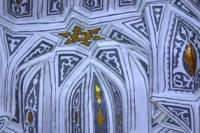You are here
The Temirid female necropolis


Excursion tourism across Samarkand with visiting ancient monuments.
"A mean to find a calm is to be together under the ground, as Suleiman was taken away by the wind with the beloved, which was a jewel on the seal of happiness"
Its entrance there is an inscription in Farsi.
Bus and walking tour in Samarkaand.
The middle group of Shahi-Zinda necropolis developed on the ancient wall coping at the time of Amir Temur. In this period, a functional accent of the necropolis had changed. It became a country necropolis for members of the royal family and elite.
While Dorus-Siadat and Gur-Emir were male necropolises of the Temurids, Shahi - Zinda became a female necropolis of this dynasty, which patron was Kusam ibn Abbas. Mausoleum of Uldjai Shadi-Mulk the tomb of Amir Temur niece, Uldjai Shadi-Mulk-aga (died in 1372), the daughter of Kutlug-Turkan-aga the elder sister of Amir Temur, who was married his companion, emir Daud Duglat.
She helped to Temur in 1362, when he was captured by the Turkmen, and then hid him in her house in Samarkand. The mausoleum has a ribbed dome and fine portal decorated with a carved majolica.
A decade later, in 1383, inconsolable mother of Shadi-Mulk, Kutlug-Turkan-aga died and was buried beside her daughter. Probably, it was intended, when the mausoleum was under construction, as above its entrance there is an inscription in Farsi: "A mean to find a calm is to be together under the ground, as Suleiman was taken away by the wind with the beloved, which was a jewel on the seal of happiness".
The mausoleum has a portal-dome planning. The ribbed dome crowns the small cube. The foundations are absent. The burial chamber has not been opened, but external survey has revealed, that under the floor there are two individual rectangular vaulted chambers extended at axis "north-south".
Enameled terracotta tiles and polychromic painted majolica form the decor. The palette - dark blue. On the mausoleum, there are names of masters Shamseddin, Bareddin and Zaineddin Bukhari.
The mausoleum of Shirin-bek-aga. This new dynastical tradition was continued by construction of the mausoleum for the younger sister of Sohibkiran - Shirin-bek-aga, died in 1386. The mausoleum was located opposite the mausoleum of Shadi-Mulk forming "kosh" composition.
The initiative to construct the most refined mausoleum of the necropolis, is attributed to Amir Temur. We should note one unique feature of this mausoleum. On portal pylons, there are sayings of Socrates.
On the right: "A person in this world feels heart pain because of all its circumstances"; on the left: "Actually the people in this world are similar to birds being ever joyful this world is similar to the net with a bait".
This mausoleum belongs to the Iranian stylistic circle. The double dome lays on the drum with windows, due to which the interior is very light. Inside, the white background with light paintings dominates: on the dome - ornament, on walls - ornament and landscape.
New decor components appeared - composing mosaic and polychromic paintings on ganch plaster. Later and up to the XVIIth century, mosaic decoration in sapphire - dark blue palette, applied on the portal and panels, had superseded all other kinds of decor and occupied dominant positions in monumental architecture of Maverannahr.
Authority:
Alexey Arapov. Samarkand. Masterpieces of Central Asia. Tashkent, Sanat. 2004.
Photos
Alexander Petrov.







